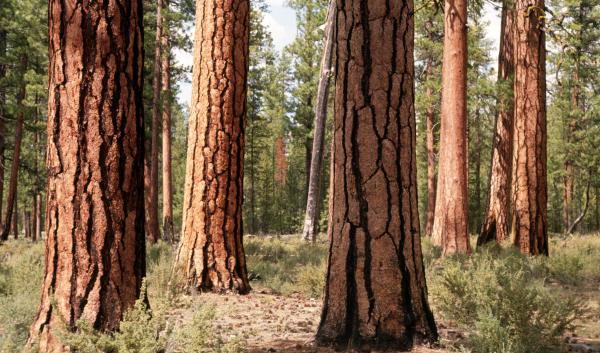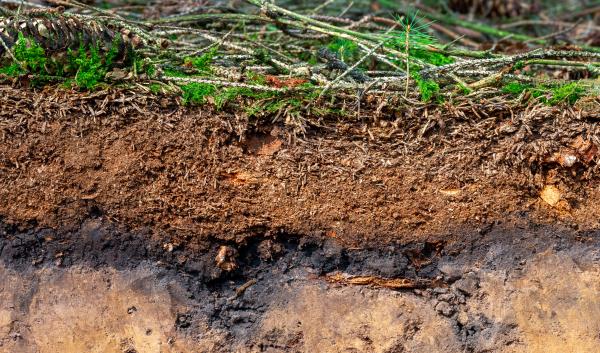What is soil carbon?
In soils, carbon is a component of soil organic matter. Soil organic matter is a complex mixture of living and dead organisms in the soil that allows soil to carry out important jobs like supplying nutrients and enhancing soil structure.
As living and dead organisms decompose, they become part of the soil organic matter, releasing nutrients for plants and other organisms to use. Carbon is the dominant element in soil organic matter, accounting for 58%, on average. Organic matter also contains a plethora of other nutrients and minerals, including nitrogen and phosphorus. The texture of soil organic matter improves soil structure. It binds soil particles together to store water and hold plant roots in place. Carbon is constantly moving between soil organic matter, living organisms, and the atmosphere. The amount of carbon in soil at any given time is dependent on the balance of carbon fluxes in and out.
The carbon cycle
The terrestrial carbon cycle is the movement of carbon through Earth's land and air. In the carbon cycle, carbon resides in “stocks”, including the atmosphere, living organisms, and soil. Carbon moves between stocks via several different “fluxes." Carbon is transferred from the atmosphere to plants through photosynthesis, the process by which plants take in carbon dioxide from the atmosphere. Carbon moves from plants into soil in multiple forms. As plants grow, they release root exudates(carbon-rich liquid) into surrounding soil. Plants also release parts of their tissue into soil, like leaves and roots. Carbon is released from soil and plants back into the atmosphere as carbon dioxide through fire and decomposition by microbes.

Carbon moves through each of Earth's ecosystems differently. In the Northwest, forests store, or “sequester,” a considerable amount of their carbon aboveground in large trees. Rangelands, however, contain a lot of carbon belowground in deep plant roots. The amount of carbon stored in soils affects the amount of carbon dioxide in the atmosphere, and therefore, the global climate.
Climate and soil carbon
As carbon moves from soil into the atmosphere, it takes the form of carbon dioxide. Carbon dioxide is a powerful greenhouse gas that insulates Earth’s atmosphere and increases global temperatures. Conversely, as carbon moves from the atmosphere into plants through photosynthesis, it is transformed into sugars and plant tissue that will eventually form soil organic matter. Climate warming can be reduced by keeping carbon in plants and soil, and not in the atmosphere as carbon dioxide.
Climate affects soil carbon uniquely across the Northwest. For example, the area east of the Cascade Mountains receives less rainfall than the west. Eastern dry lands lose less carbon through decomposition, and more through wildfire. Climate effects also vary from state to state in the Northwest. Alaska is the only Northwest state where carbon is stored in frozen soil, or permafrost. As the climate warms, thawing permafrost will release carbon into the atmosphere. Northwest land managers can measure soil carbon over time to determine how climate warming and management are impacting soil carbon storage.
Measuring soil carbon
Soil carbon is defined and measured in many ways. Total soil carbon reflects the total amount of carbon in the soil overall. Total soil carbon increases as carbon moves into soil from plants and other organisms and decreases as carbon moves out of soil and into the atmosphere via fire and decomposition. Other measurements show distinct types of carbon that soil organisms use differently. For example, soil carbon is commonly measured as "fast," "slow," and "passive" pools. Each pool decomposes over a different amount of time and fulfills a different role in soil.
"Fast" or "Active": Soil organic matter that decomposes over days or weeks. Active carbon measures how much "food" is available to soil organisms like microbes. This pool responds to management within weeks and can provide land managers with an early indication of soil carbon sequestration. Methods for measuring the active pool include: soil respiration.
"Slow": Soil organic matter that decomposes over multiple years. This pool contains larger particles that must be broken down before they can be consumed by organisms. This pool can be measured every 5 years to understand how soil carbon is changing over time in response to climate and management changes. Methods for measuring the slow pool include: particulate organic matter and soil enzymes.
"Passive": Soil organic matter that decomposes over multiple decades. Of particular importance for soil carbon sequestration, carbon in this pool is chemically glued to minerals in the soil. This makes the passive pool largely resistant to being lost to the atmosphere as carbon dioxide. This pool can be measured every 10 years to determine how much stable carbon is being stored in soil. Methods for measuring the passive pool include: mineral-associated organic matter.
Land managers can measure soil carbon themselves, or send their soils to a local lab to be measured by scientists. Total soil carbon and individual carbon pool measurements serve as indicators of soil health. In the Northwest, higher soil carbon translates to healthier crops, forests, pastures, and livestock.

Managing soil carbon
Many policies and programs are available to help Northwest businesses and land managers increase soil carbon storage. Federal and state legislation provides land managers with financial support to adopt conservation management practices. Many such practices increase soil carbon directly by adding organic material to soil, or indirectly by reducing soil carbon losses. Programs that support soil carbon storage include: the Conservation Reserve Program, the Conservation Stewardship Program, and the Environmental Quality Incentives Program. Local offices, including Natural Resource Conservation Service (NRCS) service centers and conservation district offices, provide land managers with technical and administrative support to enroll in these programs.




